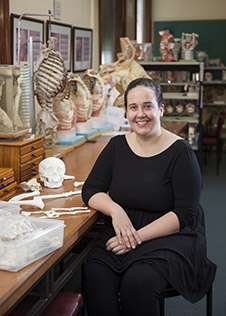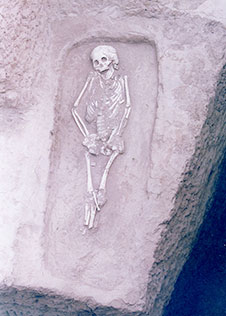
Associate Professor Sian Halcrow
A remarkable 5000-year-old skeleton suggests human dwarfism was both accepted and respected in life and death in ancient China, research by a University of Otago bio-archaeologist shows.
Associate Professor Sian Halcrow, from the University's Department of Anatomy, led the study on the skeleton and the stories it could tell.
The individual, a young adult referred to as burial M53, lived during the late Neolithic Yangshao period between 5300–4900 years ago in Guanjia – in Henan Province on the Central Plains of China.
M53 displayed evidence for skeletal dysplasia, characterised by proportional stunting of the long bones and a small axial skeleton, weakened bones and lack of skeletal maturity.
While firmly establishing age and gender was not possible, M53's remarkably well-preserved skeleton did offer up an intriguing insight into their life and death.
“They would have been visibly smaller than all other adults in the population,” Associate Professor Halcrow says.
“But they lived into adulthood so it's likely they were the recipient of care from other members in their family or wider society.”

The skeleton of M53
While it was difficult to model exactly what that care would have looked like at the time of M53's life, there is little doubt it existed, she says.
“That's because the dysplasia likely had some associated health effects from an early age, and that would have meant M53 would have had extra care needs.”
Associate Professor Halcrow says the research tells a compelling story about how those living in the Henan Province 5000 years ago accepted each other – regardless of their physical differences.
“I think it is important for us to recognise that disability and difference can be found in the past, but that these things did not necessarily have negative connotations, socially or culturally. The ancient historical texts show that they may have, in fact, been revered in some situations.”
The research was co-authored by Dr Melanie Miller and Dr Anne Marie Snoddy from Otago, Dr Wenquan Fan of the Henan Provincial Institute of Cultural Relics and Archaeology, and Associate Professor Kate Pechenkina of Queens College, New York.
Publication
The research was published this week in the International Journal of Paleopathology.
For more information, contact:
Associate Professor Sian Halcrow
Department of Anatomy
Tel +64 3 479 5265
Email sian.halcrow@otago.ac.nz
Craig Borley
Communications Adviser
Division of Health Sciences
Mob +64 21 279 4144
Email craig.borley@otago.ac.nz
FIND an Otago Expert
Use our Media Expertise Database to find an Otago researcher for media comment.
